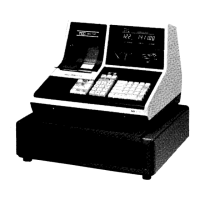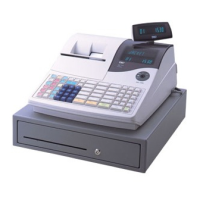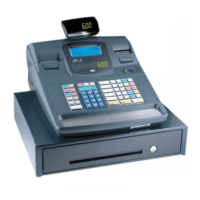- 21 -
EO1-11126
MA-1350-1 SERIES
NOTES: 1. Numeric keys are used to enter PLU Codes or numeric values of program data, etc. but
not to enter the numerics as characters.
2. Characters not shown on the keyboard on the preceding page can be entered by the
Character Code Entry Method.
Using the PK-2 (PLU Keyboard; hardware option):
The PK-2 (hardware option PLU Keyboard) is used to enter the required PLU Code by simply depress the
PLU Preset-code Key on the PK-2 keyboard in the “REG”, “MGR”, or “ - ” mode. In addition, the PK-2
can be used to enter characters directly during the programming operations that require character set-
tings, such as Store Message and Commercial Message Programming, PLU Table Setting, Changing, or
Deletion, etc.
The figure below shows the key indications of the PK-2 keyboard. (A sheet of these character indications
is attached to the PK-2 unit. Insert it between the film layers that cover the PK-2 keyboard for using the
keyboard for this purpose.)
Instead of entering a 2- or 3- digit character code and depressing the [#/NS] key on the ECR keyboard, a
simple depression of the appropriate key on the PK-2 keyboard will be the character entry.
All the function keys, such as [@/FOR], [ST], [#/NS], [AT/TL], etc. must be operated on the ECR side.
Any characters not listed on the template may be entered by the Character Code Entry method on the
ECR keyboard (the characters even listed on the template may be entered as well by that method).
Please note also that the keys “0” to “9” in the figure below function as character keys but do not function
for code entries. Any code entries, for Item Codes, Address Nos, etc. must be entered through the Nu-
meric Keys on the ECR keyboard.
The One Double-size Declaration (by depressing the [@/FOR] key once prior to the required character)
and the All Double-sized Declaration (by depressing [@/FOR] twice before all the characters) are the
same as in the Character Code Entry method.
11 21131516141 71 91
7
10181
8
111
9
121
12 22232526242 72 92
4
10282
5
112
6
122
13 23333536343 73 93
1
10383
2
113
3
123
@
14
#
24
!
4
$
34 54
&
64
%
44
*
74
)
94 104
(
84
0
114 124
w
15
e
25
q
5
r
35
y
55
u
65
t
45
i
75
p
95 105
o
85 115 125
s
16
d
26
a
6
f
36
h
56
j
66
g
46
k
76 96 106
l
86
+
116 126
x
17
c
27
z
7
v
37
n
57
m
67
b
47 77
’
97
-
10787
=
117 127
W
18
E
28
Q
8
R
38
U
68
T
48
I
78
P
98
[
108
O
88
]
118 128
S
19
D
29
A
9
F
39
H
59
J
69
G
49
K
79 99
:
109
L
89 , 119 129
X
20
C
30
Z
10
V
40
N
60
M
70
B
50
SPACE
80
/
100
?
110
.
90 120 130
Y
58
